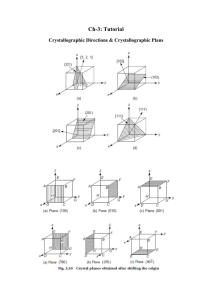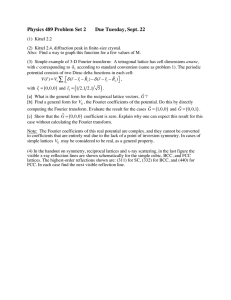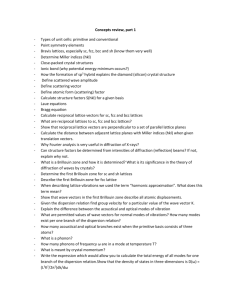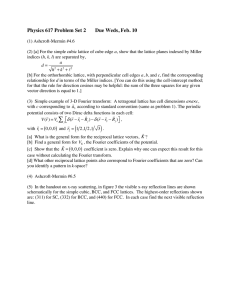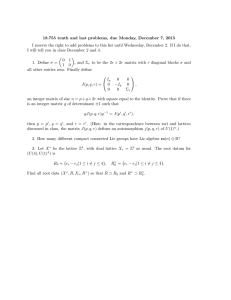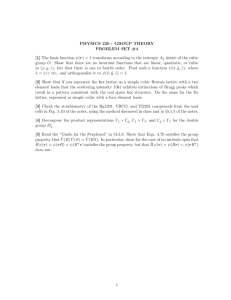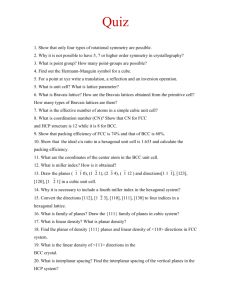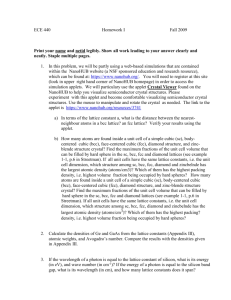A Fast Fourier Transform with Rectangular Output on the BCC and
advertisement
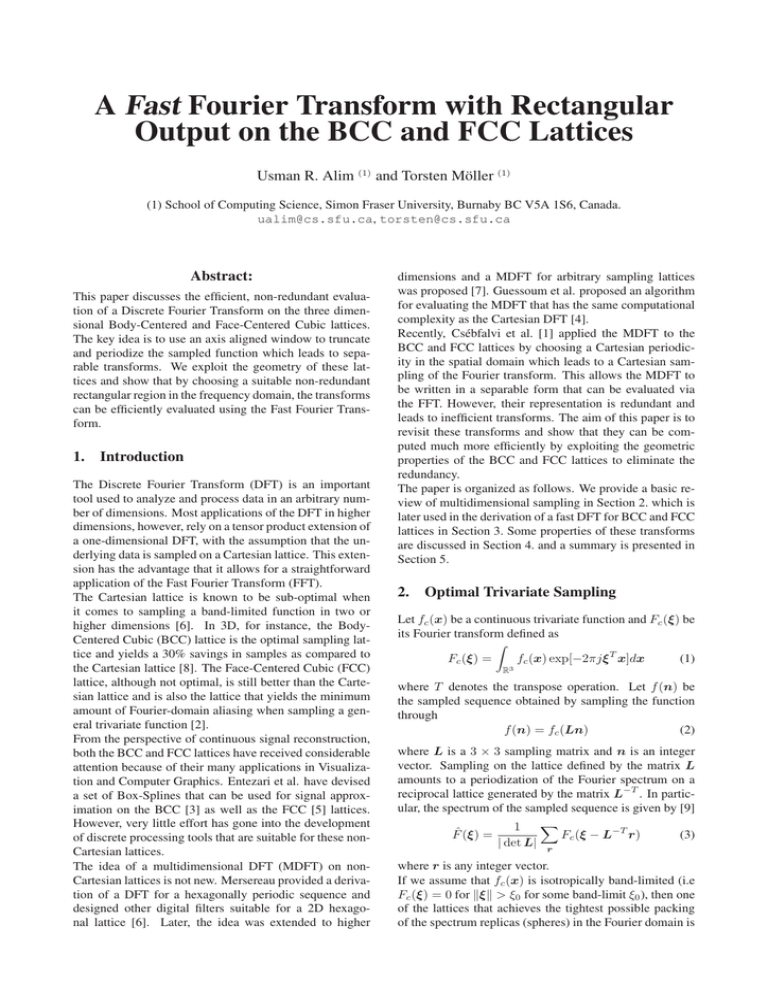
A Fast Fourier Transform with Rectangular
Output on the BCC and FCC Lattices
Usman R. Alim (1) and Torsten Möller (1)
(1) School of Computing Science, Simon Fraser University, Burnaby BC V5A 1S6, Canada.
ualim@cs.sfu.ca, torsten@cs.sfu.ca
Abstract:
This paper discusses the efficient, non-redundant evaluation of a Discrete Fourier Transform on the three dimensional Body-Centered and Face-Centered Cubic lattices.
The key idea is to use an axis aligned window to truncate
and periodize the sampled function which leads to separable transforms. We exploit the geometry of these lattices and show that by choosing a suitable non-redundant
rectangular region in the frequency domain, the transforms
can be efficiently evaluated using the Fast Fourier Transform.
1.
Introduction
The Discrete Fourier Transform (DFT) is an important
tool used to analyze and process data in an arbitrary number of dimensions. Most applications of the DFT in higher
dimensions, however, rely on a tensor product extension of
a one-dimensional DFT, with the assumption that the underlying data is sampled on a Cartesian lattice. This extension has the advantage that it allows for a straightforward
application of the Fast Fourier Transform (FFT).
The Cartesian lattice is known to be sub-optimal when
it comes to sampling a band-limited function in two or
higher dimensions [6]. In 3D, for instance, the BodyCentered Cubic (BCC) lattice is the optimal sampling lattice and yields a 30% savings in samples as compared to
the Cartesian lattice [8]. The Face-Centered Cubic (FCC)
lattice, although not optimal, is still better than the Cartesian lattice and is also the lattice that yields the minimum
amount of Fourier-domain aliasing when sampling a general trivariate function [2].
From the perspective of continuous signal reconstruction,
both the BCC and FCC lattices have received considerable
attention because of their many applications in Visualization and Computer Graphics. Entezari et al. have devised
a set of Box-Splines that can be used for signal approximation on the BCC [3] as well as the FCC [5] lattices.
However, very little effort has gone into the development
of discrete processing tools that are suitable for these nonCartesian lattices.
The idea of a multidimensional DFT (MDFT) on nonCartesian lattices is not new. Mersereau provided a derivation of a DFT for a hexagonally periodic sequence and
designed other digital filters suitable for a 2D hexagonal lattice [6]. Later, the idea was extended to higher
dimensions and a MDFT for arbitrary sampling lattices
was proposed [7]. Guessoum et al. proposed an algorithm
for evaluating the MDFT that has the same computational
complexity as the Cartesian DFT [4].
Recently, Csébfalvi et al. [1] applied the MDFT to the
BCC and FCC lattices by choosing a Cartesian periodicity in the spatial domain which leads to a Cartesian sampling of the Fourier transform. This allows the MDFT to
be written in a separable form that can be evaluated via
the FFT. However, their representation is redundant and
leads to inefficient transforms. The aim of this paper is to
revisit these transforms and show that they can be computed much more efficiently by exploiting the geometric
properties of the BCC and FCC lattices to eliminate the
redundancy.
The paper is organized as follows. We provide a basic review of multidimensional sampling in Section 2. which is
later used in the derivation of a fast DFT for BCC and FCC
lattices in Section 3. Some properties of these transforms
are discussed in Section 4. and a summary is presented in
Section 5.
2.
Optimal Trivariate Sampling
Let fc (x) be a continuous trivariate function and Fc (ξ) be
its Fourier transform defined as
Z
fc (x) exp[−2πjξ T x]dx
(1)
Fc (ξ) =
R3
where T denotes the transpose operation. Let f (n) be
the sampled sequence obtained by sampling the function
through
f (n) = fc (Ln)
(2)
where L is a 3 × 3 sampling matrix and n is an integer
vector. Sampling on the lattice defined by the matrix L
amounts to a periodization of the Fourier spectrum on a
reciprocal lattice generated by the matrix L−T . In particular, the spectrum of the sampled sequence is given by [9]
X
1
Fc (ξ − L−T r)
(3)
F̂ (ξ) =
| det L| r
where r is any integer vector.
If we assume that fc (x) is isotropically band-limited (i.e
Fc (ξ) = 0 for kξk > ξ0 for some band-limit ξ0 ), then one
of the lattices that achieves the tightest possible packing
of the spectrum replicas (spheres) in the Fourier domain is
the FCC lattice. Thus, in order to sample a trivariate bandlimited function optimally, the function should be sampled
on the reciprocal of the FCC lattice, i.e. the BCC lattice.
3.
Discrete Fourier Transform
If the sequence f (n) is non-zero within a finite region, it
can be periodically extended spatially and represented as a
Fourier series which is a sampled version of the transform
(3) [7]. The pattern with which the continuous transform
(3) is sampled in the Fourier domain depends on the periodicity pattern in the spatial domain. Merserau et al. [7]
used a periodicity matrix to define the periodic extension
of the finite sequence. Here, we use a somewhat different approach by splitting the sampled sequence into constituent Cartesian sequences [1].
The BCC and FCC lattices LB and LF are generated by
the integer sampling matrices
h 1 −1 1 i
h1 0 1i
LB = −1 1 1 and LF = 0 1 1
1
1 −1
110
respectively. Both these lattices are based on a cubic sampling pattern whereby, in addition to samples at the eight
corners of a cube, LB has an additional sample in the center of the cube and LF has six additional samples on the
faces. Both these lattices can also be built from shifts of a
Cartesian sublattice as shown in Fig. 1. In particular, samples that lie on the corners of cubes form the sublattice
2Z3 . The quotient group LB /2Z3 is isomorphic to Z2 and
the quotient group LF /2Z3 is isomorphic to Z4 . Therefore, LB can be partitioned into two Cartesian cosets while
LF has four Cartesian cosets (Fig. 1).
choose a cuboid shaped fundamental region generated by
limiting n to the set N := {n ∈ Z3 : 0 ≤ n1 <
N1 , 0 ≤ n2 < N2 , 0 ≤ n3 < N3 } for some positive integers N1 , N2 and N3 . This region consists of 2N1 N2 N3
data points (i.e. Voronoi cells) and has a total volume of
8N1 N2 N3 h3 . If we define N to be the diagonal matrix
diag(N1 , N2 , N3 ), then the two subsequences f0 (n) and
f1 (n) contained within the fundamental region can be periodically extended on a Cartesian pattern such that they
satisfy
f0 (n + N r) = f0 (n) and
f1 (n + N r) = f1 (n),
3
for all n and r in Z .
This Cartesian periodic extension in the spatial domain
amounts to a Cartesian sampling in the Fourier domain.
In particular, the continuous transform (3) is sampled at
1
N −1 k yielding the sequence
the frequencies ξ = 2h
F (k) =F̂ (ξ) 1
ξ= 2h N −1 k
−2πj T −1
k N 2hIn +
2h
n∈N
−2πj T −1
k N (2hIn + ht)
f1 (n) exp
2h
X
f0 (n) + f1 (n) exp −πjkT N −1 t ·
=
n∈N
(4)
exp −2πjkT N −1 n ,
=
X
f0 (n) exp
where k = (k1 , k2 , k3 )T ∈ Z3 is the frequency index
vector. The above equation defines a forward BCC DFT.
Since it is a sampled version of a continuous transform that
is periodic on an FCC lattice, it should be invariant under
translations that lie on the reciprocal lattice generated by
1
the matrix (hLB )−T = 2h
LF . This property is easily
demonstrated as follows. If r ∈ Z3 , then after substituting
1
ξ = 2h
(N −1 k + LF r) in (4) and simplifying, we get
1
(N −1 k + LF r)
2h
X
f0 (n) + f1 (n) exp −πj(kT N −1 + r T LF )t ·
=
n∈N
exp −2πj(kT N −1 + r T LF )n
1
=F̂ ( N −1 k),
2h
F̂
Figure 1: Left, the BCC lattice, a 16 point view. Right, the FCC lattice, a
32 point view. Lattice sites that are Voronoi neighbors are linked to each
other. Cosets are indicated by different colors.
3.1
BCC DFT
The BCC lattice with arbitrary scaling is obtained via the
sampling matrix hLB where h is a positive scaling parameter. The Voronoi cell is a truncated octahedron having a
volume of | det hLB | = 4h3 . The Voronoi cell of the reciprocal FCC lattice is a rhombic dodecahedron having a
volume of 4h1 3 . Since LB has two Cartesian cosets, a sampled sequence can be split up into two subsequences given
by
f0 (n) = fc (2hIn) and
f1 (n) = fc (2hIn + ht),
where I is the 3 × 3 identity matrix, t is the translation
vector (1, 1, 1)T and n = (n1 , n2 , n3 )T is any integer
vector. f0 (n) is the sequence associated with the first
coset while f1 (n) is associated with the second. Since
these sequences are sampled on a Cartesian pattern, a
straightforward truncation of the original sequence is to
since r T LF n is always an integer and r T LF t is always
even.
One fundamental period of the BCC DFT is contained
within a rhombic dodecahedron of volume 4h1 3 . The
sampling density in the frequency domain is given by
1
| det 2h
N −1 | = (8N1 N2 N3 h3 )−1 . Thus, the fundamental period consists of a total of 2N1 N2 N3 distinct frequency samples which is the same as the number of distinct spatial samples.
The inverse BCC DFT is obtained by summing over all
the distinct sinusoids and evaluating them at the spatial
sample locations. This gives
1 X
F (k) exp 2πjkT N −1 n
(5a)
f0 (n) =
N
k∈K
1 X
1 f1 (n) =
F (k) exp 2πjkT N −1 (n + t) (5b)
N
2
k∈K
where N = 2N1 N2 N3 is the number of samples and
K ⊂ Z3 is any set that indexes all the distinct frequency
samples. It is easily verified that both the sequences (5a)
and (5b) are periodic with periodicity matrix N .
3.1.1 Efficient Evaluation
Since N is diagonal, the kernel in both equations (4)
and (5) is separable. This suggests that the transform
can be efficiently computed via the rectangular multidimensional FFT, provided that a suitable rectangular index set K can be found. Observe that the Cartesian sequence F (k) is periodic with periodicity matrix 2N , i.e
F (k + 2N r) = F (k) for all r ∈ Z3 . Therefore, one
way to obtain a rectangular index set is to choose K such
that it contains all the frequency indices within one period
generated by the matrix 2N . This consists of a total of
| det 2N | = 4N indices and hence contains four replicas
of the fundamental rhombic dodecahedron.
A non-redundant rectangular index set can be found by
exploiting the geometric properties of the FCC lattice. If
we consider the first octant only, 4N samples are contained within a cube formed by the FCC lattice sites that
have even parity. This cube also contains six face-centered
sites. By joining any two axially opposite face-centered
sites, we can split the cube into four rectangular regions
such that each region consists of non-redundant samples
only. Six rhombic dodecahedra contribute to such a region
as illustrated in Fig. 2. The non-redundant region shown
in Fig. 2b is obtained by limiting k to the index set given
by K = {k ∈ Z3 : 0 ≤ k1 < N1 , 0 ≤ k2 < N2 , 0 ≤
k3 < 2N3 }.
(a)
(b)
Figure 2: (a) Six rhombic dodecahedra contribute to a non-redundant
rectangular region. (b) Zoomed in view of the non-redundant rectangular
region that contains the full spectrum split into six pieces. ξ1 , ξ2 and ξ3
indicate the principal directions in the frequency domain.
This region can further be subdivided into two cubes
stacked on top of each other, each containing N1 ×N2 ×N3
samples. The forward transform (4) can then be evaluated
in the two cubes separately by appropriately applying the
Cartesian FFT to the two sequences f0 (n) and f1 (n) and
combining the results together. After rearranging terms in
(4), the forward transform in the bottom cube becomes
X
F0 (k) = F (k) =
f0 (n) exp −2πjkT N −1 n +
n∈N
X
(6)
exp[−πjkT N −1 t]
f1 (n) exp −2πjkT N −1 n ,
n∈N
where k is now restricted to the set N . Since this equation is valid for all k ∈ Z3 , the forward transform in
the top cube can be computed from (6) by F1 (k) =
F0 (k + (0, 0, N3 )T ) which simplifies to
X
F1 (k) =
f0 (n) exp −2πjkT N −1 n −
n∈N
X
(7)
exp[−πjkT N −1 t]
f1 (n) exp −2πjkT N −1 n ,
n∈N
for k ∈ N . Equations (6) and (7) are now in a form that
permits a straightforward application of the Cartesian FFT.
Since the two equations are structurally similar, only two
N1 × N2 × N3 FFT computations are needed, one for the
sequence f1 (n) and one for f2 (n).
In a similar fashion, the inverse transform (5) can be computed using two inverse FFT computations. Splitting the
summations in (5) into the two constituent cubes gives
1 X
(F0 (k) + F1 (k)) exp 2πjkT N −1 n ,
f0 (n) =
N
k∈N
1 X
f1 (n) =
(F0 (k) − F1 (k)) exp[πjkT N −1 t] ·
N
k∈N
(8)
exp 2πjkT N −1 n .
3.2
FCC DFT
The FCC lattice with arbitrary scaling is generated by the
sampling matrix hLF . The rhombic dodecahedral Voronoi
cell has a volume of | det hLF | = 2h3 . The frequency
spectrum is replicated according to (3) on a reciprocal
BCC lattice that has a truncated octahedral Voronoi cell
having a volume of 2h1 3 .
A sequence sampled on the FCC lattice can be split up into
four Cartesian subsequences corresponding to the four
Cartesian cosets. Each subsequence is given by
fi (n) = fc (2hIn + hti ),
where i ∈ {0, 1, 2, 3} and ti are the integer shift vectors
(0, 0, 0)T , (1, 0, 1)T , (0, 1, 1)T and (1, 1, 0)T respectively.
Analogous to the BCC case, let us choose a rectangular
truncation of the original sequence by limiting n to the set
N and extend the sequences periodically so that they satisfy fi (n+N r) = fi (n). This truncation yields a rectangular fundamental region in the spatial domain consisting
of a total of N = 4N1 N2 N3 distinct samples. Therefore,
each truncated octahedron in the frequency domain tessellation will consist of N distinct points that are sampled
1
in a Cartesian fashion at the frequencies ξ = 2h
N −1 k
3
where k ∈ Z . The sampled sequence in the frequency
domain is thus given by
1
F (k) = F̂ ( N −1 k)
2h
3
(9)
XX
1 =
fi (n) exp −2πjkT N −1 (n + ti ) .
2
i=0
n∈N
This defines a forward FCC DFT. Like the BCC case, it is
1
invariant under shifts of the type ξ = 2h
(N −1 k + LB r)
making it periodic on a BCC lattice with one fundamental
period contained in a truncated octahedron.
The inverse FCC DFT is obtained by summing over all the
distinct sinusoids evaluated at the spatial sample locations
1 X
F (k) exp 2πjkT N −1 (n+ 21 ti ) , (10)
fi (n) =
N
k∈K
where K ⊂ Z3 is any set that indexes all the N distinct
sinusoids.
3.2.1 Efficient Evaluation
Since N is diagonal, the key to efficiently evaluating the
FCC DFT pair (9) and (10) is to choose a suitable rectangular region in the frequency domain that contains N distinct samples. Similar to the BCC DFT, the sequence (9)
is 2N periodic with one complete rectangular period containing | det 2N | = 2N samples and hence two complete spectrum replicas. These 2N samples are contained
within a cube, the corners of which lie at the even parity
points of the BCC lattice. This cubic region can be split
into two by halving along any of the three principal directions yielding a rectangular region that contains only
non-redundant samples as illustrated in Fig. 3. The index
set that spans the region depicted in Fig. 3b is given by
K = {k ∈ Z3 : 0 ≤ k1 < 2N1 , 0 ≤ k2 < 2N2 , 0 ≤ k3 <
N3 }.
computes only two N1 × N2 × N3 FFTs for the BCC case
and four N1 × N2 × N3 FFTs for the FCC case.
Any operation in the frequency domain must respect the
arrangement of the different portions of the spectrum. The
BCC DFT splits the spectrum into six parts as illustrated
by the six pieces (two lunes and four spherical triangles)
of the sphere in Fig. 2b. The FCC transform splits the frequency spectrum into five parts as indicated by the hemisphere and the four spherical triangles in Fig. 3b.
5.
Summary
In this paper, we have shown that a MDFT of a Cartesian
periodic sequence sampled on the BCC or FCC lattices
can be efficiently evaluated using the FFT. The BCC lattice can be represented as two shifted Cartesian lattices.
This representation leads to a separable transform that is
efficiently computed via two non-redundant FFT evaluations of the Cartesian subsequences. Similarly, the FCC
lattice consists of four shifted Cartesian lattices and the
MDFT requires four non-redundant FFT evaluations.
References:
(a)
(b)
Figure 3: (a) Five truncated octahedra contribute to a non-redundant rectangular region. (b) Zoomed in view of the rectangular region that contains the full spectrum.
The non-redundant region can be split into four N1 ×N2 ×
N3 cubic subregions and the forward transform (9) can be
evaluated in each of the subregions separately by appropriately applying the FFT to each of the subsequences fi (n)
and combining the output. The derivation is very similar
to the BCC case and we leave the details to the reader. The
forward transform in each subregion can be written as
Fm (k) =
3
X
Him exp[−πjkT N −1 ti ]·
i=0 X
(11)
fi (n) exp −2πjkT N −1 n ,
n∈N
where m ∈ {0, 1, 2, 3}, k ∈ N and
1 H1im 1is an
element of
1
1 −1 1 −1
the 4 × 4 Hadamard matrix H = 1 1 −1 −1 . The four
1 −1 −1
1
subregions Fm (k) have their bottom left corners at the frequency index vectors (0, 0, 0)T , (N1 , 0, 0)T , (0, N2 , 0)T
and (N1 , N2 , 0) respectively.
Likewise, the inverse transform (10) can be evaluated using four inverse FFT evaluations, one for each of the subsequences. This yields
fi (n) =
4.
3
X
1 X
Him Fm (k) ·
exp[πjkT N −1 ti ]
N
k∈N
m=0
(12)
exp 2πjkT N −1 n .
Discussion
The decomposition of the non-redundant region in the frequency domain into cubes leads to transforms that are
much more efficient. Both the BCC and FCC DFTs proposed by Csébfalvi et al. [1] are redundant and require the
FFT of a 2N1 ×2N2 ×2N3 sequence. In contrast, our proposed evaluation strategy eliminates the redundancy and
[1] B. Csébfalvi and B. Domonkos. Pass-Band Optimal
Reconstruction on the Body-Centered Cubic Lattice.
In Vision, Modeling, and Visualization 2008: Proceedings, October 8-10, 2008, Konstanz, Germany,
page 71. IOS Press, 2008.
[2] A. Entezari. Optimal Sampling Lattices and Trivariate Box Splines. PhD thesis, Simon Fraser University,
Vancouver, Canada, July 2007.
[3] A. Entezari, D. Van De Ville, and T. Möller. Practical
box splines for volume rendering on the body centered
cubic lattice. IEEE Transactions on Visualization and
Computer Graphics, 14(2):313 – 328, 2008.
[4] A. Guessoum and R. Mersereau. Fast algorithms
for the multidimensional discrete Fourier transform.
IEEE Transactions on Acoustics, Speech, and Signal
Processing, ASSP-34(4):937–943, 1986.
[5] M. Kim, A. Entezari, and J. Peters. Box Spline Reconstruction on the Face Centered Cubic Lattice. IEEE
Transactions on Visualization and Computer Graphics (Proceedings Visualization/Information Visualization 2008), 14(6):1523–1530, 2008.
[6] R. Mersereau. The Processing of Hexagonally Sampled Two-dimensional Signals. Proceedings of the
IEEE, 67(6):930–949, June 1979.
[7] R. Mersereau and T. Speake. The processing of periodically sampled multidimensional signals. IEEE
Transactions on Acoustics, Speech, and Signal Processing, (1):188–194, 1983.
[8] T. Theußl, T. Möller, and M. Gröller. Optimal regular
volume sampling. In Proceedings of the conference on
Visualization’01, pages 91–98. IEEE Computer Society Washington, DC, USA, 2001.
[9] P. Vaidyanathan.
Fundamentals of multidimensional multirate digital signal processing. Sadhana,
15(3):157–176, 1990.
